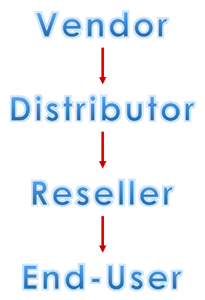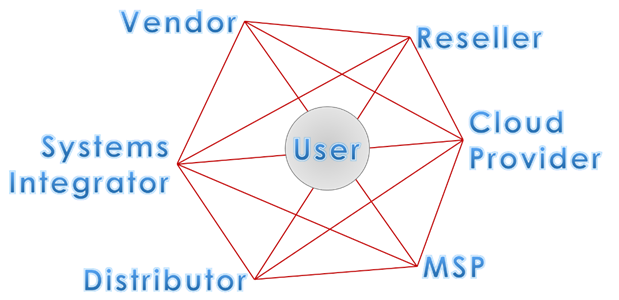Channel used to be easy. I don’t mean easy for the average man in the street (who thinks it’s a brand of perfume or something you change with a remote). I mean it was easy for those of us actually in the channel. We all understood how it worked. Vendors sold to distributors, who then distributed to resellers, who then resold to end-users (the actual buyers). Everyone knew what they were supposed to do and everyone was happy.
But then Cloud showed up, and the world started to change. Buyers decided they didn’t want to buy technology. So resellers decided they didn’t want to resell. Which meant distributors had less to distribute. And when that happens, technology vendors start to panic. Did this spell the end of this channel thingy we’d all grown to love?
Back in the good old days (when software came in a cardboard box the size of a brick and people wanted to own their own servers) the channel model was very linear.
It looked like this:

But the advent of Cloud has added a level of complexity that does not lend itself to linearity. Unlike the traditional model which involved the distribution of physical goods, Cloud is about the distribution of risk. In other words, when a customer moves their IT requirements into the cloud they are effectively shifting the risk of running technology (both financial and technical) to their provider. As an example, imagine if the “Y2K Bug” had occurred in the Cloud era – it would have been the MSPs, not the users, who would have had to upgrade their systems (at no extra cost to the customer).
The difference with risk is that it’s not something you store in a warehouse.
Now if we look at another industry that specialises in managing risk (ie. Insurance industry) we will uncover an interesting creature … namely, the reinsurer. These are companies with seriously deep pockets that, for a fee, will take some of the risk of the primary insurer. So if something really bad happens, like a hurricane wiping out a city, some of the claims are paid by the reinsurer, which means that the primary insurer is also not wiped out. (think of it as insurance companies working with other insurance companies to spread risk).
Now let’s look at the IT channel…
Partners are working with other partners when they don’t have a capability in a certain area. Distributors are providing services to end-users but billing it under the partner’s name. Partners are promoting vendors where they make no margin on the product, but do on the services. Services companies are selling services to partners who resell them to end-users as if it was their own service. And resellers are selling services to distributors who then resell them to other resellers.
In effect, IT organisations are starting to defer the risk to other IT organisations who are better suited to managing that risk. In some cases it might be financial risk, and in other cases, it might be technical risk. Either way, IT companies are starting to focus on what they’re good at, and giving someone else the stuff they’re not good at.
So now the new channel model starts to look like this:

It’s less of a line and more of an Ecosystem (the 2nd most overused word in the last 12 months after Cloud). And all those nice clean delineations we used to have before are starting to blur. Even our naming conventions are starting to blur (can I still call you a Reseller if you’re not reselling someone else’s product?).
The good news is … the customer doesn’t care!
As long as they get a solution that meets their needs, have a single point of contact for enquiries or when things go wrong, and can get it at a price point they’re happy with, they don’t care who else is behind it. They just want a partner who can make it simple.
But if you look at the diagram above, it’s anything but simple. Which brings us to what’s driven the IT industry for the last 30 years.
Where there’s complexity, there’s margin.
And the companies that can find a way to navigate this new complexity will prosper, and those who try and hang on to the original linear model are going to find it more and more difficult.
So what are the key take-aways?:
-
- Traditional Partner Programs that relied on Platinum/Gold/Silver tiers are going to struggle to adequately recognise the partners that are actually creating business.
- Partners (Distributors, Resellers, MSPs, etc) are going to care less about product features and more about business applications, use cases, and how they bill and support solutions.
- Enablement and on-boarding will change from being something we do at the start of a new relationship to something we do for the entire duration of the relationship.
- New partner recruitment is going be more challenging, especially finding the new emerging partners who have never operated in the traditional linear model.
- Vendors and distributors are going to have to become more comfortable working with their competitors (resellers have been doing it for years)
What other changes do you see? Is your organisation facing these challenges? Drop me a line and let me know what you think at mmoses@channeldynamics.com.au


